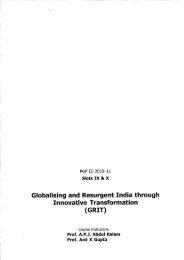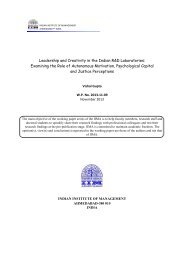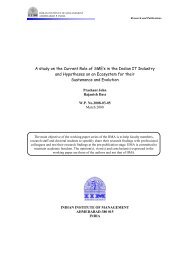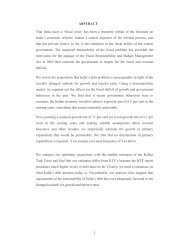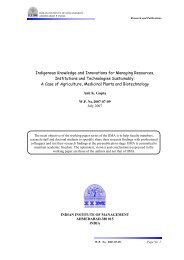to Download (English) File - Indian Institute of Management ...
to Download (English) File - Indian Institute of Management ...
to Download (English) File - Indian Institute of Management ...
Create successful ePaper yourself
Turn your PDF publications into a flip-book with our unique Google optimized e-Paper software.
IIMA INDIA<br />
Research and publications<br />
increase consumer price sensitivity (Kaul and Wittink 1995), as several low-cost airlines have<br />
demonstrated. When price comparisons are not easy, firms can create perceptions <strong>of</strong> greater price cuts<br />
through frequent but small price cuts (Alba et. al. 1999) In some cases, a firm can attempt <strong>to</strong> reverse<br />
the valence associated with an attribute from positive <strong>to</strong> negative or vice versa. For example, causerelated<br />
advertising has been used <strong>to</strong> reverse ‘cus<strong>to</strong>mer’ preferences and behavior (e.g., smoking<br />
cessation and safe sex).<br />
Finally, a third form <strong>of</strong> decision context setting entails altering the legal and regula<strong>to</strong>ry<br />
constraints under which market players must operate. Altering laws and regulations impacts market<br />
players’ decision-making process, thereby altering their behavior. For example, multinational firms<br />
<strong>of</strong>ten lobby <strong>to</strong> alter government trade policies (Y<strong>of</strong>fie and Milner 1988). Such efforts can, for<br />
example, effectively increase or reduce market entry and exit barriers for market players (Farell et al.<br />
1992; Varadarajan, Clark and Pride 1992).<br />
Contractual Announcements<br />
Firms use deliberate announcements as cues <strong>to</strong> inform (and elicit reactions from) market<br />
players (Harvey, Lusch and Richey 2002). Contractual Announcements refer <strong>to</strong> announcements made<br />
by a firm about its impending contractual arrangements such as distribu<strong>to</strong>r agreements, licensing, and<br />
acquisitions. Senior managers spend a fair amount <strong>of</strong> time on the signals they send out <strong>to</strong> a market<br />
because <strong>of</strong> their potential impact (Harvey, Lusch and Richey 2002). As noted earlier, contractual<br />
arrangements such as alliances and licensing can potentially affect the structure and behavior <strong>of</strong> a<br />
market. Announcements about impending contractual arrangements can help a firm <strong>to</strong> accelerate the<br />
intended changes in market structure or behavior (Hultink and Langerak 2002; Lilley and Walters<br />
1997).<br />
For example, a firm may wish <strong>to</strong> grow a market by licensing its technology <strong>to</strong> a large number<br />
<strong>of</strong> players including competi<strong>to</strong>rs and complemen<strong>to</strong>rs. By announcing its intention <strong>to</strong> license its<br />
technology <strong>to</strong> all interested, a firm can accelerate interest in its technology, predispose players<br />
favorably <strong>to</strong> the technology, as well as dissuade other players from investing in rival technologies.<br />
W.P. No. 2013-05-07 Page No. 13



